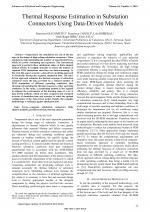| 3/2016 - 4 |
Thermal Response Estimation in Substation Connectors Using Data-Driven ModelsGIACOMETTO, F. |
| Extra paper information in |
| Click to see author's profile in |
| Download PDF |
Author keywords
computer simulation, connectors, finite element methods, predictive models, thermal analysis
References keywords
engineer(8), comput(7), neural(6), jcie(6), indust(6), simulation(5), process(5), finite(5), element(5), time(4)
No common words between the references section and the paper title.
About this article
Date of Publication: 2016-08-31
Volume 16, Issue 3, Year 2016, On page(s): 25 - 30
ISSN: 1582-7445, e-ISSN: 1844-7600
Digital Object Identifier: 10.4316/AECE.2016.03004
Web of Science Accession Number: 000384750000004
SCOPUS ID: 84991096061
Abstract
Temperature rise simulations are one of the key steps in the design of high-voltage substation connectors. These simulations help minimizing the number of experimental tests, which are power consuming and expensive. The conventional approach to perform these simulations relies on finite element method (FEM). It is highly desirable to reduce the number of required FEM simulations since they are time-consuming. To this end, this paper presents a data-driven modeling approach to drastically shorten the required simulation time. The data-driven approach estimates the thermal response of substation connectors from the data provided by a reduced number of FEM simulations of different operating conditions, thus allowing extrapolating the thermal response to other operating conditions. In the study, a partitioning method is also applied to enhance the performance of the learning stage of a set of data-driven methods, which are then compared and evaluated in terms of simulation time and accuracy to select the optimal configuration of the data-driven model. Finally, the complete methodology is validated against simulation tests. |
| References | | | Cited By |
Web of Science® Times Cited: 3 [View]
View record in Web of Science® [View]
View Related Records® [View]
Updated today
SCOPUS® Times Cited: 4
View record in SCOPUS® [Free preview]
View citations in SCOPUS® [Free preview]
[1] Review of Electrical Connectors for Underwater Applications, Remouit, Flore, Ruiz-Minguela, Pablo, Engstrom, Jens, IEEE Journal of Oceanic Engineering, ISSN 0364-9059, Issue 4, Volume 43, 2018.
Digital Object Identifier: 10.1109/JOE.2017.2745598 [CrossRef]
[2] Real-Time Prediction of Curing Processes using Model Order Reduction, Frank, Tobias, Zeipel, Henrik, Wielitzka, Mark, Bosselmann, Steffen, Ortmaier, Tobias, IFAC-PapersOnLine, ISSN 2405-8963, Issue 2, Volume 53, 2020.
Digital Object Identifier: 10.1016/j.ifacol.2020.12.273 [CrossRef]
Disclaimer: All information displayed above was retrieved by using remote connections to respective databases. For the best user experience, we update all data by using background processes, and use caches in order to reduce the load on the servers we retrieve the information from. As we have no control on the availability of the database servers and sometimes the Internet connectivity may be affected, we do not guarantee the information is correct or complete. For the most accurate data, please always consult the database sites directly. Some external links require authentication or an institutional subscription.
Web of Science® is a registered trademark of Clarivate Analytics, Scopus® is a registered trademark of Elsevier B.V., other product names, company names, brand names, trademarks and logos are the property of their respective owners.
Faculty of Electrical Engineering and Computer Science
Stefan cel Mare University of Suceava, Romania
All rights reserved: Advances in Electrical and Computer Engineering is a registered trademark of the Stefan cel Mare University of Suceava. No part of this publication may be reproduced, stored in a retrieval system, photocopied, recorded or archived, without the written permission from the Editor. When authors submit their papers for publication, they agree that the copyright for their article be transferred to the Faculty of Electrical Engineering and Computer Science, Stefan cel Mare University of Suceava, Romania, if and only if the articles are accepted for publication. The copyright covers the exclusive rights to reproduce and distribute the article, including reprints and translations.
Permission for other use: The copyright owner's consent does not extend to copying for general distribution, for promotion, for creating new works, or for resale. Specific written permission must be obtained from the Editor for such copying. Direct linking to files hosted on this website is strictly prohibited.
Disclaimer: Whilst every effort is made by the publishers and editorial board to see that no inaccurate or misleading data, opinions or statements appear in this journal, they wish to make it clear that all information and opinions formulated in the articles, as well as linguistic accuracy, are the sole responsibility of the author.



